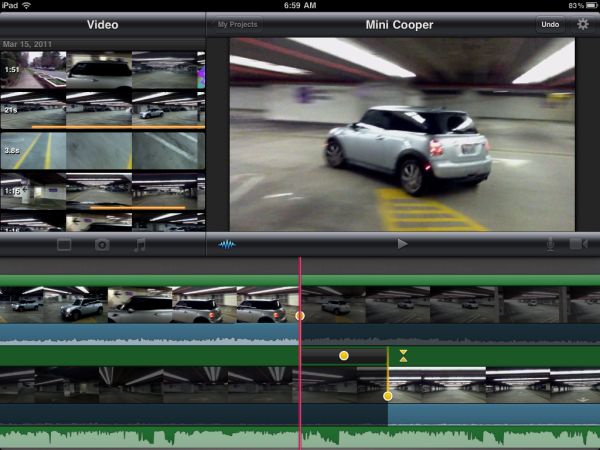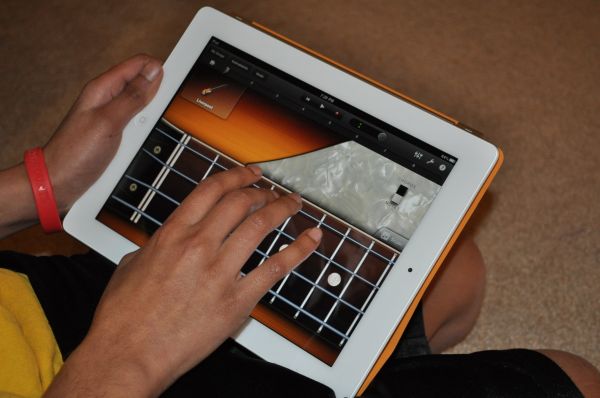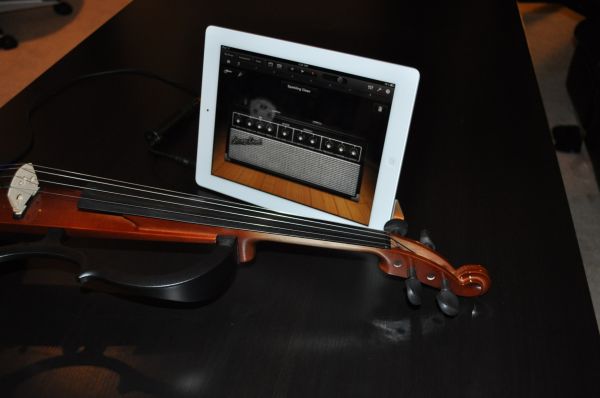The Apple iPad 2 Review
by Brian Klug, Anand Lal Shimpi & Vivek Gowri on March 19, 2011 8:01 PM ESTiMovie
by Vivek Gowri
Apple launched two new content-editing apps along with the iPad 2 - GarageBand and iMovie. iMovie is a $4.99 app available exclusively for iPad 2 (an updated iPhone 4/iPod touch 4 equivalent was launched simultaneously), so I'll start there.
iMovie basically lets you do a decent amount of video editing on the iPad itself. You can edit videos shot on the iPad, or video content imported from SD card using the camera connection kit. Unfortunately as we discovered in our testing, nearly all other sources of video aren't supported by iMovie. If you have grand visions of doing all of your video editing on the iPad 2 you'll want to hit the reset button on your expectations (or wait a few years until it's actually possible). Honestly, I can only see myself using it for video shot with the iPad, it makes the entire video editing process very streamlined on the device and makes video editing something you can do on the go. Just to test it out, I shot a series of videos of my car and stitched them together using iMovie, then added some titles and a soundtrack.
Being able to touch and swipe through the video clips and change the transitions and video cut points using a tactile input method actually makes it a lot easier to use than one would expect. Swipes and gestures rule the day, and it's a great way to edit various clips and put them together in a cohesive manner.
There's not a lot in the way of different options to deal with crossfades and transitions between clips, but the cross dissolve transition that is used as a default is pretty decent for amateur quality videos, especially since you can edit the length of the transition, and the various theme-specific transitions work too, if a little bit tacky.
But this is a video editing app for a 1.3lb tablet; considering that fact, you can get some pretty solid quality video out of it at the end. I'm pretty pleased with the video that I got out at the end, take a look for yourself.
You get a decent number of export options - Facebook, Youtube, Vimeo, CNN iReport (there's a CNN iMovie theme that can be added to videos as well), iTunes, and Camera Roll. From the camera roll, you can copy it to a computer and basically do whatever you want with it. iMovie isn't going to replace any serious video editing application, but I can see it being very useful during CES or another tradeshow - shooting video on the iPad, cutting it down, adding a few transitions, and uploading it in a matter of minutes, all from the same device.
Garage Band
by Vivek Gowri
GarageBand is a new app that Apple is releasing for both generations of iPad, for the same $4.99 price as iMovie, and beyond the basic premise of creating audio tracks from scratch, it's actually not that similar to the desktop app.
Apple has loaded a few instruments in GarageBand - a set of piano and keyboard options, a few drum kits, a vocal sampler/audio recorder from the mic, and even a virtual guitar amp, but the real story is the "Smart Instruments" that they have included.
Meet my brother, Gokul Gowri. He's 12, in 7th grade, and plays violin and piano at a relatively high level. I handed him my iPad 2 with GarageBand and asked him for his impressions.
After messing around with the included piano, he started experimenting with Smart Instruments. The first thing he said was that Smart Instruments could basically play the instrument for you, making good sounding audio clips and multilayered tracks easy to compose for even non-musically inclined people. There are four Smart Instruments - Piano, Bass, Guitar, and Drums. The Guitar is probably the most impressive one of the lot, with 6 strings and the ability to pick or strum at them. The cool part though, is that Smart Instruments will add the chords for you. They're preset chords and unfortunately, users can't define their own chords. That would let more advanced musicians really customise the guitar to their liking (my brother abandoned the smart chords really quickly after discovering he couldn't change them). The nice thing is that you can turn them off and pick your notes on the 6 strings individually. Smart Bass is exactly the same, except it's a four string bass instead of a guitar.
Smart Piano works similarly in that it takes away the actual keys and gives you a pad to press to get the note, with an option to sustain the notes. Smart Drums is another interesting one - you're provided with a grid dependant on volume and pattern complexity that you drag the various drum elements onto to generate a full rhythm.
And then of course, there's autoplay. Press the note, it'll play an entire clip for you, with the complexity of the clip depending on the level of autoplay selected. It's pretty cool if you're not a music person, but if you are, you can actually produce an interesting rhythm with the different options in Smart Instruments. There's a maximum of 8 tracks allowed, and you can duplicate and loop them to create a full song.
My brother decided to hold an impromptu recording session and ended up with this:
It sounds pretty good, especially considering that it was produced by a 12 year old on an iPad in 30 minutes. What my brother ended up doing is layering all four smart instruments to start, then adding in some included loops of orchestra strings to generate the second half of the clip. Pretty simple stuff, which is the goal behind GarageBand - allowing users to create complex sounds using simple musical constructs.
I personally was more curious about the virtual guitar amp. I'm a violinist who's been using an electric for the last couple of years, and I was curious to see if I could actually make use of the amp. I thought Apple would be using some form of line-in 3.5mm connector, but unfortunately, you have to get an external device to connect the electric guitar/violin. Apple recommends Apogee's Jam, though the AmpliTube iRig also works. I picked up an iRig ($39) to test out, since it's significantly cheaper than the $99 Apogee Jam, but the Jam is a studio quality device, so it's probably worth the extra money if you're really serious about it.
Unfortunately, the amp itself isn't all that great, for an electric violin at least. As a violinist, I have a different set of priorities than a guitarist - a clean sound is kind of the ultimate goal, even if a metal or some other after effect is applied. Most of the amp options in the virtual guitar amp don't give you very clear sound, so the violin ends up sounding pretty terrible. After listening to me play through the amp, my best friend took to calling my iPad the GarbageBand guitar amp. I think it'd be better for electric guitar players, since there isn't as much emphasis on clear sound, but it isn't going to replace a real amp by any stretch of the imagination.

















189 Comments
View All Comments
TareX - Sunday, March 20, 2011 - link
Irrelevant, but is Anandtech gonna do an Atrix review?name99 - Sunday, March 20, 2011 - link
"The Digital AV adapter is a bit clunky and I believe the future of this is clearly in some form of wireless transmission, but for now it plugs directly into the dock connector. "You mean the wireless transmission that ALREADY EXISTS called AirPlay?
Apple HAVE a solution to your hatred of wires. You seem to be upset that they don't have a solution that somehow magically transports video from iPad to your (HDMI and nothing else) TV using some non-existent wireless standard that isn't actually built into your TV.
It's fine to be frustrated at some of the idiocies in tech, but it's truly silly to complain about this one. Apple provides this cable for one, and only one, group of users --- people who actually NEED that physical wire.
BlendMe - Sunday, March 20, 2011 - link
AirPlay doesn't mirror tha iPads screen, it only allows you to stream content. For now. And for AirPlay you need an Apple TV or another AirPlay enabled device. The HDMI adapter allows you to hook it up to almost any recent TV, monitor or beamer.ananduser - Sunday, March 20, 2011 - link
In fact there is a standard already built in in most modern(emphasis on modern) TVs. It is called DLNA. Unfortunately Apple decided that coercing you into using their ecosystem ONLY is the way to go. Personally I find Apple's modus operandi of not giving 2 sh*ts about other 3rd party solutions one of the "idiocies in tech" as you well put it.Regardless, the iPad2(or 1) is a cool gadget(emphasis on gadget) nonetheless. Combined with leading parental controls as:no flash(as a porn enabler), no porn(appstore policy), no bloody/gory games(appstore policy) and a damn spartan simple and fast GUI makes it a great basic computing device for the naive crowd(parents, grandparents etc.). IMO it really shines for children as their 1st computing platform.
That it is also a frequent choice for the tech literate few, good on them... it still is best suited, IMO, for those of the above.
name99 - Sunday, March 20, 2011 - link
Can both of you not read?I was referring to, as I quoted, "The Digital AV adapter is a bit clunky and I believe the future of this is clearly in some form of wireless transmission, but for now it plugs directly into the dock connector. "
How do either of your comments have any relevance to that?
If you want Wifi, you need something that accepts a Wifi signal. Your TV doesn't have Wifi built in, so, yeah, you need some other box.
And DLNA? Really? You want to go there? Go explore the DLNA web pages (http://www.dlna.org/products is a good start) and tell me this pile of turds is EVER going to be relevant to the real world. For god's sake, man, get in touch with the real world. Compare that web page and everything it implies about compatibility nightmares and technobabble with the Apple TV web page.
Anand Lal Shimpi - Monday, March 21, 2011 - link
AirPlay is really for specific content at this point. I'm referring to the future of video out on tablets in general. And I didn't mention it as a knock against the iPad today, just a heads up that in some future version of the iPad you won't need a physical adapter (at least not on your tablet). When you have full wireless display mirroring then you can start introducing more interesting usage models - e.g. tablet as a desktop replacement, tablet as a game console, etc... You can do these things without wireless display but they are definitely enhanced by it being there.Take care,
Anand
Ushio01 - Sunday, March 20, 2011 - link
When ifixit did there teardown of the first ipad it was shown that apart from the battery and the antennas all the other components were kept up the top so why can't a tablet simply be a dock you slot a smartphone in that supplies a larger screen and additional battery's?That to me is a far more appealing device than current tablets.
kmmatney - Monday, March 21, 2011 - link
makes sense to me. I can't see Apple doing this, but maybe on of the Android makers can come up with something along these lines. I'd love to be able to pop my phone into the back of a tablet and use the bigger screen. I'd just keep it near the couch.zmatt - Sunday, March 20, 2011 - link
I still hold that the entire market segment (not just the iPad) is a solution looking for a problem. The idea seems cool but in reality nobody was asking for the tablet. And after using them I still can't see what the attractiveness is other than people buying them cause they are "cool". I take calls and get mobile updates on my Galaxy S, which is more than competent enough for light work such as taking down notes or answering emails on the go. Any real work I do with a computer. I'm sorry but you can't make up for the lack of performance and a real keyboard if you are talking about getting work done. The iPad may be nice for mobile entertainment, but if i already have an mp3 player and a laptop what can it do that they can't? For tablets to be viable productivity devices and not just toys i think they would basically have to evolve into laptops. So again i ask, what's the point?cucurigu - Sunday, March 20, 2011 - link
Thanks a lot for your review, Anand, Brian and Vivek - I was waiting for your opinion on the iPad 2 as it was a gadget most appealing but, as you said, very polarizing for the reviewers.There is something I didn't really understand, even after rereading the Xoom review - both you (Anand and Brian) said the first iPad wasn't your cup of tea in the long run and chances are the new one won't change this (but you're giving it another go). The general impression (one which I also got while looking at the tablet segment) is characterized by their unclear niche - where do they really fit ?
If I understand correctly the first tablet (ipad) didn't integrate with your workflow and the reasons seem to apply to all tablets, however, this sentiment doesn't come off so clearly from the Xoom article - so I wondered : did you have the impression the Android OS was more adequate to your usage patterns ? Meaning, if the Xoom and iPad 2 where left on your desk, which one would you choose to take with you, and for which purpose ?
Once again, thanks and best regards !